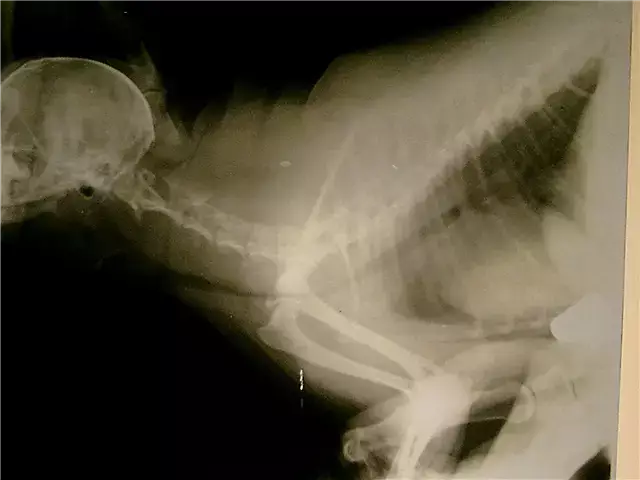- Author Rachel Wainwright [email protected].
- Public 2023-12-15 07:39.
- Last modified 2025-11-02 20:14.
Etazol
Instructions for use:
- 1. Pharmacological action
- 2. Release form
- 3. Indications for use
- 4. Contraindications
- 5. Method of application
- 6. Drug interactions
- 7. Side effects
- 8. Storage conditions
Etazol is an antibacterial drug for systemic use in the treatment of infections of the skin, ENT organs and respiratory tract.
Pharmacological action Etazol

The active component of Etazol has antibacterial activity against pneumococci, streptococci, gonococci, meningococci, the causative agent of dysentery, Escherichia coli, as well as pathogenic anaerobic microorganisms.
Etazole according to the instructions is low-toxic and, as a rule, is well tolerated by patients.
Release form
Etazole is available in three dosage forms:
- Tablets of 250 and 500 mg;
- Granules for preparing a suspension for children, in 150 ml vials with an active substance content of 60 g;
- Solution for injection, in ampoules of 5 and 10 ml, containing 100 or 200 mg of active substance.
Etazol's analogs by mode of action are the following drugs:
- Tablets Norsulfazole, Sulfadimezin, Urosulfan;
- Liniment, ointment and powder for local and external use Streptocid;
- Sulfacyl sodium injection solution.
Indications for Etazol's use
The drug Etazol is prescribed in the treatment of infections that cause microorganisms sensitive to the action of the active substance (infections of the skin, ENT organs, biliary and respiratory tract), namely:
- Bronchitis;
- Erysipelas;
- Pneumonia;
- Bacterial enterocolitis;
- Pyelitis;
- Gonorrhea;
- Dysentery;
- Cystitis.
In addition, Etazol is effective for the prevention of infectious complications after surgery.
Contraindications
According to the instructions Etazol is contraindicated for use with:
- Anemia;
- Renal failure;
- Azotemia;
- Congenital deficiency of glucose-6-phosphate dehydrogenase;
- Liver failure;
- Porphyrias;
- Nephrourolithiasis;
- Hypersensitivity to the components of Etazole;
Pregnancy, like the lactation period, is a contraindication to the use of Etazol.
Method of using Etazol

Etazole tablets are prescribed according to the instructions:
- For adults - 2 tablets (500 mg) up to six times a day, but not more than 7 g of the drug per day;
- Children's dosage depends on age and ranges from 0.3 g (up to 2 years old) to 0.5 g (over 6 years old) six times a day.
The course of treatment with Etazol according to the instructions varies from seven to ten days.
Etazole Granules are intended for young children who have difficulty taking the tablets. Before use, the granules are dissolved in warm freshly boiled water, bringing the volume of water to the mark of 100 ml. The resulting suspension must be shaken periodically for half an hour.
The dosage of the suspension depends on the age of the child. The interval between doses should not exceed four hours. The course of treatment is 7-10 days.
Solution for injection Etazole is administered intramuscularly or slowly intravenously every eight hours. The maximum adult daily dose is 6 g of Etazol.
Drug interactions
When using Etazol in any dosage form, it should be borne in mind that the drug:
- Enhances the effect of oral and antiepileptic hypoglycemic drugs and anticoagulants;
- Increases the risk of side effects from the use of immunosuppressants, cytostatics, nephrotoxic and hepatotoxic drugs.
The manifestations of etazole hematotoxicity enhance myelotoxic drugs.
Side effects of Etazol
According to reviews, Etazol is well tolerated in most cases. In rare cases, the use of Etazol can lead to the development of:
- Hemolytic anemia;
- Headache;
- Medicinal hepatitis;
- Leukopenia;
- Dizziness;
- Interstitial nephritis;
- Thrombocytopenia;
- Dyspepsia (in the form of nausea, abdominal pain, vomiting, diarrhea);
- Methemoglobinemia;
- Crystalluria;
- Agranulocytosis.
The most likely allergic reactions when taking Etazol include:
- Toxic epidermal necrolysis (otherwise - Lyell's syndrome);
- Skin rash;
- Anaphylactic shock;
- Malignant exudative erythema.
Storage conditions
Etazole belongs to a number of Prescription List B drugs. The shelf life of the drug is from three to five years (depending on the dosage form).
Information about the drug is generalized, provided for informational purposes only and does not replace the official instructions. Self-medication is hazardous to health!






